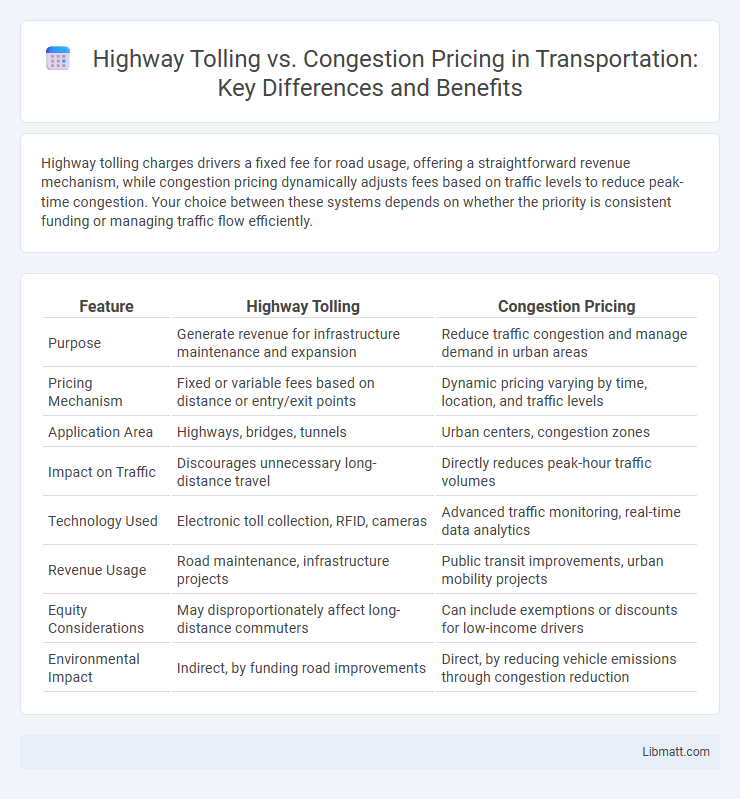Highway tolling charges drivers a fixed fee for road usage, offering a straightforward revenue mechanism, while congestion pricing dynamically adjusts fees based on traffic levels to reduce peak-time congestion. Your choice between these systems depends on whether the priority is consistent funding or managing traffic flow efficiently.
Table of Comparison
| Feature | Highway Tolling | Congestion Pricing |
|---|---|---|
| Purpose | Generate revenue for infrastructure maintenance and expansion | Reduce traffic congestion and manage demand in urban areas |
| Pricing Mechanism | Fixed or variable fees based on distance or entry/exit points | Dynamic pricing varying by time, location, and traffic levels |
| Application Area | Highways, bridges, tunnels | Urban centers, congestion zones |
| Impact on Traffic | Discourages unnecessary long-distance travel | Directly reduces peak-hour traffic volumes |
| Technology Used | Electronic toll collection, RFID, cameras | Advanced traffic monitoring, real-time data analytics |
| Revenue Usage | Road maintenance, infrastructure projects | Public transit improvements, urban mobility projects |
| Equity Considerations | May disproportionately affect long-distance commuters | Can include exemptions or discounts for low-income drivers |
| Environmental Impact | Indirect, by funding road improvements | Direct, by reducing vehicle emissions through congestion reduction |
Understanding Highway Tolling: An Overview
Highway tolling involves charging drivers a fixed or variable fee for using specific roadways, primarily to fund infrastructure maintenance and expansion. This system generates direct revenue based on vehicle usage and can help manage demand during peak periods by adjusting toll rates. Unlike congestion pricing, which varies fees dynamically to reduce traffic congestion, highway tolling often emphasizes cost recovery and infrastructure investment.
What Is Congestion Pricing? Key Concepts
Congestion pricing is a dynamic tolling strategy designed to reduce traffic jams by charging drivers higher fees during peak travel times, encouraging off-peak trips and improved traffic flow. Unlike traditional highway tolling, which typically applies a fixed fee for road usage, congestion pricing varies costs based on real-time traffic conditions and demand. This approach helps manage road capacity efficiently, reduces emissions, and allows you to make cost-effective travel decisions while easing urban congestion.
Tolling vs Congestion Pricing: Fundamental Differences
Highway tolling involves charging a fixed fee for road usage, primarily aimed at funding infrastructure maintenance and construction. Congestion pricing dynamically adjusts charges based on real-time traffic conditions to reduce congestion during peak hours and manage demand. Your choice between tolling and congestion pricing impacts traffic flow, revenue generation, and urban mobility strategies.
Economic Impacts of Highway Tolling
Highway tolling generates significant revenue that can be reinvested in infrastructure maintenance and improvements, enhancing overall transportation efficiency. This revenue model encourages efficient road usage by internalizing the costs of congestion and wear, reducing inefficient driving patterns. Your local economy benefits from improved traffic flow and reduced congestion-related delays, leading to increased productivity and lower vehicle operating costs.
Congestion Pricing: Effects on Traffic Flow
Congestion pricing effectively reduces traffic congestion by charging drivers higher fees during peak travel times, encouraging the use of alternative routes or transportation modes. This dynamic pricing model improves traffic flow by lowering vehicle volume on busy roads, decreasing travel times and emissions. Studies show cities implementing congestion pricing experience significant declines in traffic delays and increased average speeds.
Technology and Implementation: Comparing Approaches
Highway tolling primarily relies on electronic toll collection systems using RFID transponders and license plate recognition cameras to charge vehicles for road usage, enabling efficient revenue collection with minimal traffic disruption. Congestion pricing employs dynamic pricing technologies that adjust toll rates based on real-time traffic data, demand patterns, and congestion levels, using advanced algorithms and GPS-enabled devices for precise implementation. Both approaches require integrated traffic management systems, but congestion pricing demands more sophisticated data analytics and adaptive infrastructure to optimize traffic flow and reduce urban congestion effectively.
Environmental Impacts: Tolling versus Congestion Pricing
Highway tolling generates revenue primarily for infrastructure maintenance but may not significantly reduce traffic emissions or congestion levels. Congestion pricing directly targets peak-hour traffic by charging variable fees, leading to decreased vehicle use, lower emissions, and improved air quality. Understanding the environmental impacts helps you choose a policy that effectively mitigates pollution and supports sustainable urban mobility.
Social Equity Concerns and Public Perception
Highway tolling often faces criticism for disproportionately burdening low-income drivers who have fewer alternative transportation options, raising significant social equity concerns. Congestion pricing can be designed with income-based discounts or exemptions to mitigate these impacts, improving fairness and public acceptance. Public perception tends to favor congestion pricing when revenue is transparently reinvested into transit improvements, enhancing trust and support among diverse communities.
Case Studies: Global Success Stories
Singapore's Electronic Road Pricing system demonstrates significant reductions in traffic congestion through dynamic tolling that varies by time and location. Stockholm's congestion tax led to a 20% decrease in vehicle entries into the city center, improving air quality and traffic flow. London's congestion charge has generated substantial revenue reinvested in public transport while reducing peak-hour traffic by approximately 30%.
Choosing the Right Policy for Urban Mobility
Highway tolling primarily generates revenue by charging drivers for road usage, while congestion pricing aims to reduce traffic by increasing costs during peak hours. Your urban mobility strategy should consider congestion pricing to effectively manage demand, improve traffic flow, and reduce emissions in densely populated areas. Data-driven analysis of traffic patterns and commuter behavior is essential to select the policy that aligns with your city's sustainability and efficiency goals.
highway tolling vs congestion pricing Infographic

 libmatt.com
libmatt.com